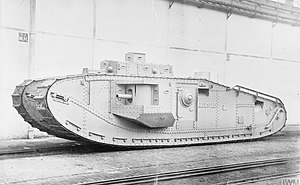
Back Mark VIII (tenk) BS Mark VIII (tanc) Catalan Mark VIII Czech Mark VIII (Panzer) German Mark VIII Greek Mark VIII (carro de combate) Spanish Tank Mark VIII French Mark VIII (tenk) Croatian Mark VIII Hungarian Kereta kebal Mark VIII Malay
This article includes a list of general references, but it lacks sufficient corresponding inline citations. (April 2009) |
| Mark VIII tank | |
|---|---|
 A British Mark VIII | |
| Type | Heavy tank |
| Place of origin | United Kingdom, United States |
| Production history | |
| Designed | 1917 |
| Manufacturer | UK: North British Locomotive Company US: Rock Island Arsenal |
| Produced | 1918–1920 |
| No. built | 125 |
| Specifications | |
| Mass | 37 long tons (38 t) (dry weight) |
| Length | 34 ft 2 in (10.41 m) |
| Width | 11 ft 8 in (3.56 m) 9 ft (2.7 m) sponsons in |
| Height | 10 ft 3 in (3.12 m) |
| Crew | 12 British tanks 10 US tanks |
| Armor | 16 mm (0.63 in) maximum |
Main armament | two QF 6 pdr 6 cwt Hotchkiss (57mm - 2.24in) guns |
Secondary armament | seven 7.92 mm Hotchkiss machine guns or five M1917 Browning machine guns |
| Engine | V-12 Liberty or V-12 Ricardo 300 hp (220 kW) |
| Power/weight | 7.89 hp/tonne (5.79 kW/t) |
| Suspension | unsprung |
Operational range | 50 mi (80 km) |
| Maximum speed | 5.25 mph (8.45 km/h) governed to 6.25 mph (10.06 km/h) maximum |
The Mark VIII tank also known as the Liberty or The International was a British-American tank design of the First World War intended to overcome the limitations of the earlier British designs and be a collaborative effort to equip France, the UK and the US with a single heavy tank design.
Production at a site in France was expected to take advantage of US industrial capacity to produce the automotive elements, with the UK producing the armoured hulls and armament. The planned production levels would have equipped the Allied armies with a very large tank force that would have broken through the German defensive positions in the planned offensive for 1919. In practice, manufacture was slow and only a few vehicles were produced before the end of the war in November 1918.
After the war, 100 vehicles assembled in the US were used by the US Army until more advanced designs replaced them in 1932. A few tanks which had not been scrapped by the start of World War II were offered to Canada for training purposes.[1]
© MMXXIII Rich X Search. We shall prevail. All rights reserved. Rich X Search